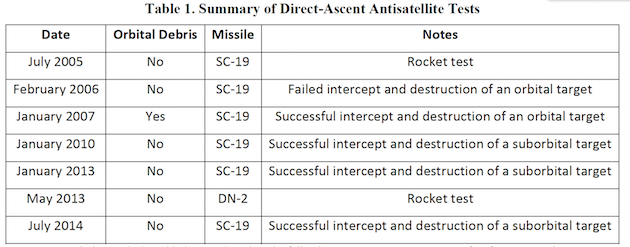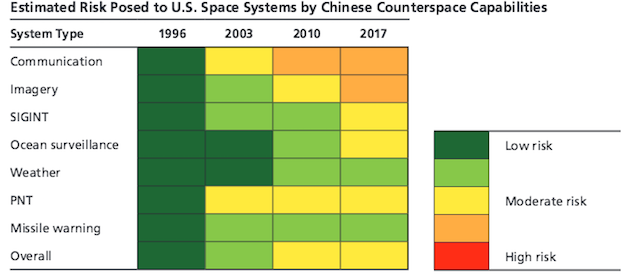Despite the subtle shows of teeth that seem to be becoming more common between the United States and China, a spokesperson at the Chinese Embassy claimed that China advocates the peaceful use of outer space and opposes space weaponization. That, of course, was after he denied having information about the missile tests.
A State official referred to a speech from February by Frank Rose, assistant secretary of State for arms control, verification and compliance, who commented on the 2014 test.
“Despite China’s claims that this was not an ASAT [anti-satellite] test; let me assure you the United States has high confidence in its assessment, that the event was indeed an ASAT test,” Rose said.
“The continued development and testing of destructive ASAT systems is both destabilizing and threatens the long-term security and sustainability of the outer space environment,” he added.
China’s most disruptive ASAT test occurred in January 2007 when a direct ascent missile destroyed a Chinese weather satellite, creating tens of thousands of debris pieces that pose a continuing danger to both satellites and manned spacecraft, like the International Space Station.
Rose said the secrecy surrounding China’s ASAT program is preventing any U.S. cooperation with Beijing on space. Cooperation will only possible after “China changes its behavior with regard to ASATs,” he said.
Documents disclosed by Wikileaks revealed that the United States and Asian allies issued protests to China over a January 2010 flight test of an anti-satellite missile from an SC-19 rocket booster.
It could not be learned if protests were lodged over the Oct. 30 test.
China’s Guancha.com reported Nov. 1 that the unusual contrails near the city of Korla, in Xinjiang province, that appeared to be signs of a spacecraft launch or possibly “a midcourse anti-missile test.”
“In recent years, similar clouds have appeared over the skies of Xinjiang many times,” the report said. “A few of them have been linked to land-based midcourse anti-missile interception tests.”
Hong Kong’s Ming Pao then reported Nov. 4 that the test appear to be a “final-phase missile interception test had been conducted in the upper atmosphere.”
“The capability to intercept was one of the capabilities of the PRC Hongqi-19 missile, and may be employed to intercept high supersonic gliding targets on the offensive,” Ming Pao stated.
A forthcoming report by the congressional U.S.-China Economic and Security Review Commission contains an entire chapter on China’s military and civilian space capabilities.
The report discusses two anti-satellite missiles, the SC-19 and the larger DN-2, which are meant to be fired in pre-determined flight paths as a satellite passes over Chinese territory.
The report suggests that China disguised its anti-satellite tests in 2010, 2013, and 2014 as missile defense interceptor tests. It stated that each test involved a high-speed intercept of a mock warhead launched by a ballistic missile and not a satellite as a way to avoid debris.
“Although China has called these tests ‘land-based missile interception tests,’ available evidence suggests they were indeed antisatellite tests,” the report said.
The May 2013 DN-2 anti-satellite test involved “nearly geosynchronous orbit” where most intelligence and navigation satellites are located. The commission described that test as demonstrating “a new high-altitude anti-satellite capability” that could be deployed as early as 2020.
The 2013 test, which reached 18,600 miles into space, was first reported by the Washington Free Beacon.
Since 2005, China has conducted seven anti-satellite direct-ascent missile tests, according to a commission report that did not include the latest DN-3 test. This is leaving many to wonder what exactly China is planning. Air Force Lt. Gen. John “Jay” Raymond, the commander of the Joint Functional Component Command for Space fears that “we are quickly approaching the point where every satellite in every orbit can be threatened.”
This is a legitimate concern. Just like the recent concern of Russian military exercises over United States communications equipment in the ocean, knocking out American satellites can be just as problematic.
Source: freebeacon.com



Are they talking about taking Big Brother down?
But we have three or four top secret weapons including the laser of death we got it from Dr. evil
Is that why Republicans keep helping China’s economy?
More cables
you must be a special kind of mentally impaired or something…
GET IN LINE! WE’RE A LITTLE BUSY RIGHT NOW!